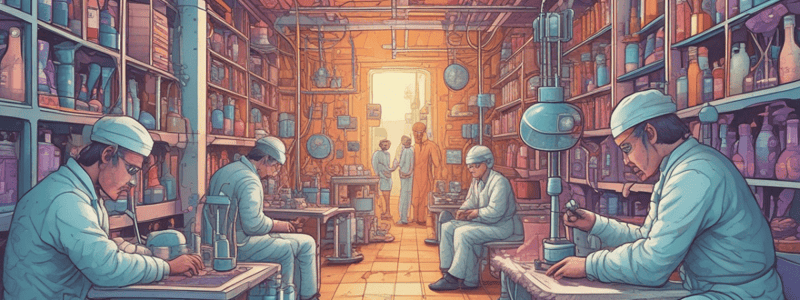Podcast
Questions and Answers
What is the primary purpose of an agar plate in microbiology?
What is the primary purpose of an agar plate in microbiology?
Agar plates provide a solid growth medium for cultivating, maintaining, and observing microorganisms.
Describe the key difference between Gram-positive and Gram-negative bacteria as revealed by Gram staining.
Describe the key difference between Gram-positive and Gram-negative bacteria as revealed by Gram staining.
Gram-positive bacteria retain the crystal violet stain due to their thick peptidoglycan layer, while Gram-negative bacteria have a thinner layer and lose the stain, becoming stained with the counterstain safranin.
Explain the significance of motility in bacteria.
Explain the significance of motility in bacteria.
Motility allows bacteria to move independently within their environment, facilitating their search for nutrients, avoidance of harmful conditions, and colonization of new areas.
What is the general principle behind biochemical tests for identifying microorganisms?
What is the general principle behind biochemical tests for identifying microorganisms?
Define the term 'serotype' in the context of microorganisms.
Define the term 'serotype' in the context of microorganisms.
What is the key ingredient in an agar plate, and what is its origin?
What is the key ingredient in an agar plate, and what is its origin?
Explain how Gram staining works to differentiate bacteria.
Explain how Gram staining works to differentiate bacteria.
Describe the purpose of a motility medium in observing bacterial movement.
Describe the purpose of a motility medium in observing bacterial movement.
What is the purpose of inoculating agar plates?
What is the purpose of inoculating agar plates?
How does inoculating broths differ from inoculating agar plates?
How does inoculating broths differ from inoculating agar plates?
What is the main function of laboratory hoods when working with microorganisms?
What is the main function of laboratory hoods when working with microorganisms?
Describe the process and purpose of serial dilution.
Describe the process and purpose of serial dilution.
What is a plate count and what does it estimate?
What is a plate count and what does it estimate?
What does the most probable number method estimate?
What does the most probable number method estimate?
Why is it important to sterilize the growth media before inoculation?
Why is it important to sterilize the growth media before inoculation?
What role does incubation play in the inoculation process?
What role does incubation play in the inoculation process?
Flashcards are hidden until you start studying
Study Notes
Microbiology Laboratory Techniques
- Inoculating agar plates involves introducing microorganisms onto a solid growth medium to observe and count their growth
- The agar plate is first sterilized and then inoculated with a small amount of microorganisms, followed by incubation under appropriate conditions
- Inoculating broths is a method of introducing microorganisms into a liquid growth medium for observation and counting their growth
- Sterilization of the broth and inoculation with a small amount of microorganisms are followed by incubation under appropriate conditions
Laboratory Safety and Preparation
- Laboratory hoods are ventilated workspaces designed to protect the user and the environment from contamination
- Hoods are used when working with potentially hazardous materials, such as microorganisms or chemicals
Microorganism Identification and Quantification
- Serial dilution is a method of preparing a series of solutions with decreasing concentrations of a substance, typically a microorganism
- Serial dilutions are used to determine the initial concentration of a microorganism in a sample or to prepare dilutions of a microorganism for use in experiments
- Plate counts estimate the number of microorganisms present on a solid growth medium, such as an agar plate
- The method involves incubating the plate, making a dilution of the medium, and plating it onto a new agar plate, with the number of colonies formed used to estimate the number of microorganisms in the original sample
- The most probable number method estimates the number of microorganisms present in a sample through serial dilution
Agar Plates and Microorganism Characteristics
- Agar plates are solid growth media used for the cultivation, maintenance, and observation of microorganisms
- Agar is a polysaccharide derived from seaweed, dissolved in a liquid nutrient broth, and poured onto a petri dish containing a solid agar base
- Grams staining is a method of staining bacteria that allows differentiation based on their cell wall structure
- Motility refers to the ability of microorganisms to move spontaneously and actively in their environment
- Biochemical tests identify and characterize microorganisms based on their metabolic activities
- Serotype refers to the specific strain or subspecies of a microorganism
Studying That Suits You
Use AI to generate personalized quizzes and flashcards to suit your learning preferences.




